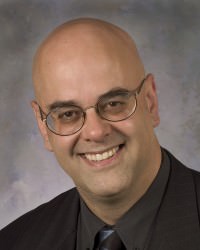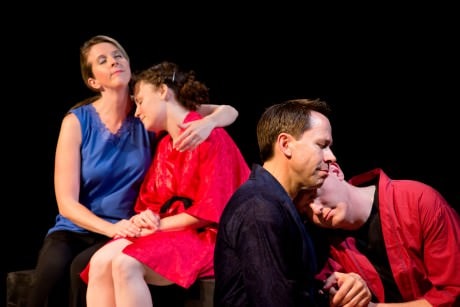How did a theater company that specializes in reviving older, often dated plays and musicals become the first to produce an inclusive I Do! I Do! for a post-DOMA America?

I originally told the American Century Theater board that I wanted to do I Do! I Do! this season for a completely different reason. Roundhouse has just cancelled its planned production after the new Artistic Director there apparently found the 1966 Schmidt and Jones musical dated, and I felt that TACT, given its mission, had an obligation to stand up for a dissed classic. After we acquired the rights and put it on the schedule, however, and the same-sex marriage debate heated up, I began to see Roundhouse’s point of view.
I Do! I Do!, like The Fourposter, the 1950 Broadway hit it was based on, tells the story of a long marriage between Michael and Agnes Snow, who take their vows in the late 19th Century. Both shows are less about the characters than they are about marriage itself, as the plot catalogues all the typical ups and downs of the institution, making the case for it as a great adventure bolstered by love and compromise. The show was more successful after the famous Robert Preston-Mary Martin Broadway production in its regional theater and dinner theater incarnations, because where the original production played like a series of predictable marriage-related songs and skits by two mega-stars who were hardly believable as young marrieds (Martin was 56), versions with less star power tended to send the message the authors intended. Marriage is the real star of I Do! I Do!
When I took a TACT delegation, including Tom Fuller, our musical director, to see a local production of the show, I was troubled. The show was strong in script and score, but our culture has changed a great deal since 1966. I’m an ethicist and a lawyer, and perhaps the fact that I had been knee deep in web discussions of the legal, moral, and ethical justifications for gay marriage was the catalyst, but for whatever reason, midway through the traditional production I began thinking a thought that had never occurred to me before: “This show would work better with same-sex couples!” As each scene and song passed before my eyes and ears, I became increasingly excited about the concept of creating an I Do! I Do! for American marriage as we were finally beginning to understand it…an institution based on love between two people, and not restricted by gender.
But you can’t just change the Snows into a gay couple, and I didn’t want to. For one thing, there are scenes, lyrics and dialogue, especially those portraying Michael’s male chauvinism, that would make no sense. I didn’t want to make major edits to the book, and legally could not. I also felt that making the couple gay would seem like a political stunt, while also distorting the true message of the musical: it’s about marriage—all marriage, not gay marriage.
I described my proposed concept to Tom Fuller on the way home. We would tell the story of the Snows using four performers, with the marriage being seen simultaneously through the prisms of a lesbian marriage, a gay male marriage, and a traditional heterosexual marriage, but morphing seamlessly from one to the other throughout the story—a single marriage, seen in different forms. I believed that this approach, rather than choosing just one representation of the Snows, would best convey the wisdom that the President embraced after the Supreme Court’s decision striking down the Defense of Marriage Act. “Marriage is marriage and love is love.”
Tom was excited about the added musical opportunities created by having four voices to combine in various ways—in a two actor musical, even if they are Preston and Martin, the sound can become tedious. To its credit, the TACT board gave us the go-ahead. But hurdles remained.
Would Harvey Schmidt and Tom Jones, the famous team responsible not only for I Do! I Do! but also The Fantasticks and 110 in the Shade, be willing to let us present their show this way? I felt that they would, given that the team has championed experimental musical theater for more than half a century. I also thought that they would be supportive of my decision to jettison the traditional, realistic fourposter bed that dominates the set of traditional productions, and to stage the show instead on a modular, non-realistic set, brilliantly designed by Patrick Lord. Props, from books to babies, would be mimed, and the show’s time frame would move from turn of the century to “anytime.” This, in turn, necessitated minor word changes to avoid dating.
A larger problem was the character names, since both “Agnes” and “Michael” had to be played by actors of both genders. This required changing the characters’ names to the gender neutral “Chris” and “Leslie/Lesley.” That, as well as the gender changes, the alteration of the original set and time period, and the text alterations were, to their great credit, approved by the authors.
Would the show play as well in the Gunston Theater Two black box as it did in my head while I was watching that traditional version eight months ago? Would audiences understand that they were watching the story of one marriage, not three, even though three different couples were portraying it? Most important of all, would this conceptual approach allow the lovely music, powerful drama, and deft comedy in the original to be seen and enjoyed by a new audience that was once excluded from the show’s celebration of marriage? Would I Do! I Do!, which has slowly become regarded as a staid and dated show suitable only for elderly couples to wallow in nostalgia, be revitalized and brought, along with the sparkling score and dialogue, into the 21st Century?

Thanks to the wonderful, courageous, talented, and trusting cast of Esther Covington, Mary Beth Luckenbaugh, Steve Lebens, and Chad Fournwalt, I think the answer to all of these questions may be “yes.” I can’t salute the cast enough for its tolerance—nothing is more frustration to an actor (I discovered) than having to leave a song midway through, or to leap into a dramatic scene that had been begun with someone else playing your character. Yet they believed in the concept, and they made it work.
The American culture’s acceptance of same-sex marriage is one of this year’s most joyous developments, and it is significant that the classic musical about marriage, I Do! I Do! so seamlessly adapts to the change. I hope to see the Washington theater-going community show its support for this I Do! I Do! to ensure that the Schmidt and Jones classic celebrates the institution of marriage as effectively in 2066 as it did in 1966 and better, as a tuneful and entertaining show about inclusive, universal, legal marriage, where two loving people set out on the great adventure of life together.
I Do! I Do! runs plays though August 17, 2013 at The American Century Theater in the Gunston Arts Center Theater II – 2700 South Lang Street, in Arlington, VA. For tickets call (703) 998-4555, or purchase them online.
LINK
David Friscic’s review of I Do! I Do! on DCMetroTheaterArts.




